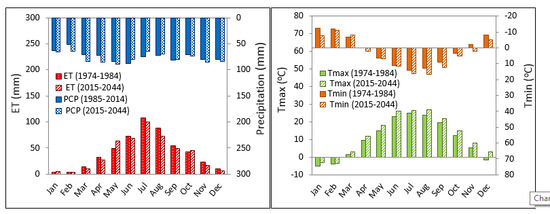Water Budget in a Tile Drained Watershed under Future Climate Change Using SWATDRAIN Model
Abstract
:1. Introduction
2. Materials and Methods
2.1. Watershed Description
2.2. Overview of SWATDRAIN Model
2.3. Climate Data
3. Results and Discussion
3.1. Model Evaluation
3.2. Climate Change Scenario
3.2.1. SDSM Calibration, Validation, and Evaluation
3.2.2. Time Series Analysis
3.3. Future Simulations
3.3.1. Streamflow
3.3.2. Sediment Loads
4. Conclusions
Acknowledgments
Author Contributions
Conflicts of Interest
References
- Zhang, X.; Srinivasan, R.; Hao, E. Predicting hydrologic response to climate change in the Luohe River basin using the SWAT model. Trans. ASABE 2007, 50, 901–910. [Google Scholar] [CrossRef]
- Hengeveld, H.G. Projections for Canada’s climate future: A discussion of recent simulations with the canadian global climate model. In Climate Change Digest Special Edition CCD 00–01; Meteorological Service of Canada Environment Canada: Downsview, ON, Canada, 2000. [Google Scholar]
- Mehdi, B.; Connolly-Boutin, L.; Madramootoo, C.A. Coping with the Impacts of Climate Change on Water Resources: A Canadian Experience. World Res. Rev. 2006, 18, 62. [Google Scholar]
- Arnold, J.G.; Fohrer, N. SWAT2000: Current capabilities and research opportunities in applied watershed modeling. Hydrol. Process. 2005, 19, 563–572. [Google Scholar] [CrossRef]
- Rosenberg, N.J.; Epstein, D.J.; Wang, D.; Vail, L.; Srinivasan, R.; Arnold, J.G. Possible Impacts of Global Warming on the Hydrology of the Ogallala Aquifer Region. Clim. Chang. 1999, 42, 677–692. [Google Scholar] [CrossRef]
- Stonefelt, M.D.; Fontaine, A.T.; Hotchkiss, R.H. Impacts of Climate Change on Water Yield in the Upper Wind River Basin. Am. Water Res. Assoc. 2000, 36, 321–336. [Google Scholar] [CrossRef]
- Hotchkiss, R.H.; Jorgensen, S.F.; Stone, M.C.; Fontaine, T.A. Regulated River Modeling for Climate Change Impact Assessment: The Missouri River. Am. Water Res. Assoc. 2000, 36, 375–386. [Google Scholar] [CrossRef]
- Wollmuth, C.J.; Eheart, J.W. Surface Water Withdrawal Allocation and Trading Systems for Traditionally Riparlan Areas. Am. Water Res. Assoc. 2000, 36, 293–303. [Google Scholar] [CrossRef]
- Bicknell, B.R.; Imhoff, J.C.; Kittle, J.L.; Donigian, A.S.; Johanson, R.C. Hydrologic Simulation Program: Fortran; User Manual for Release 11; United States Environmental Protection Agency: Washington, DC, USA, 1996.
- Golmohammadi, G.; Prasher, S.; Madani, A.; Rudra, R.; Youssef, M.A. SWATDRAIN, a new model to simulate the hydrology of agricultural lands, model development and evaluation. J. Biosyst. Eng. 2016, 141, 31–47. [Google Scholar] [CrossRef]
- Dayyani, S.; Prasher, S.O.; Madani, A.; Madramootoo, C.A. Impact of climate change on the hydrology and nitrogen pollution in a tile-drained agricultural watershed in eastern Canada. Trans. ASABE 2012, 55, 398–401. [Google Scholar] [CrossRef]
- Presant, E.W.; Wicklund, R.E. Soil Survey of Waterloo County; Report No. 44 of the Ontario Soil Survey Canada; University of Guelph: Guelph, ON, Canada, 1971. [Google Scholar]
- Hoffman, D.W.; Matthews, B.C.; Wicklund, R.E. Soil survey of Wellington County Ontario; Report No.35; Ontario Soil Survey, Department of Agriculture and Ontario Department of Agriculture: Guelph, ON, Canada, 1963.
- Carey, J.H.; Fox, M.E.; Brownlee, B.G.; Metcalfe, J.L.; Mason, P.D.; Yerex, W.H. The Fate and Effects of Contaminant in Canagagigue Creek 1. Stream Ecology and Identification of Major Contaminants; Environment Canada: Burlington, ON, Canada, 1983.
- Skaggs, R.W. Methods for Design and Evalua-tion of Drainage-Water Management Systems for Soils with High Water Tables; South National Technical Center: Missouri, MS, USA, 1980. [Google Scholar]
- Soil Conservation Service (SCS). National Engineering Handbook; USDA Soil Conservation Service: Washington, DC, USA, 1972.
- Green, W.H.; Ampt, G.A. Studies on soil physics: Part I. The flow of air and water through soils. J. Agric. Sci. 1991, 4, 1–24. [Google Scholar]
- Monteith, J.L. Evaporation and environment. Symposium. Soc. Exp. Biol. 1965, 19, 205–234. [Google Scholar]
- Hargreaves, G.H.; Samani, Z.A. Reference crop evapotranspiration from temperature. Appl. Eng. Agric. 1985, 1, 96–99. [Google Scholar] [CrossRef]
- Priestley, C.H.B.; Taylor, R.J. On the assessment of surface heat flux and evaporation using large-scale parameters. Mon. Weather Rev. 1972, 100, 81–92. [Google Scholar] [CrossRef]
- Thornthwaite, C.W. An Approach toward a Rational Classification of Climate. Geogr. Rev. 1948, 38, 55–94. [Google Scholar] [CrossRef]
- Rong, H. Water Quality Evaluation under Climate Change Impacts for Canagagigue Creek Watershed in Southern Ontario. Master’s Thesis, Department of Civil Engineering, Guelph University, Guelph, ON, Canada, 2009. [Google Scholar]
- Khan, M.S.; Coulibaly, P.; Dibike, Y. Uncertainty analysis of statistical downscaling methods using canadian global climate model predictors. Hydrol. Process. 2006, 20, 3085–3104. [Google Scholar] [CrossRef]
- Harpham, C.; Wilby, R.L. Multi-site downscaling of heavy daily precipitation occurrence and amounts. J. Hydrol. 2005, 312, 235–255. [Google Scholar] [CrossRef]
- Dibike, Y.B.; Coulibaly, P. Validation of hydrological models for climate scenario simulation: The case of saguenay watershed in quebec. Hydrol. Process. 2007, 21, 3123–3135. [Google Scholar] [CrossRef]
- Golmohammadi, G.; Prasher, R.P.; Rudra, A.; Madani, M.; Youssef, M.; Goel, P. Impact of Tile Drainage on Water Budget and Spatial Distribution of Sediment Generating Areas in an Agricultural Watershed. J. Agric. Manag. 2017, 184, 124–134. [Google Scholar] [CrossRef]
- Golmohammadi, G.; Rudra, R.P.; Prasher, S.O.; Madani, A.; Goel, P.K.; Mohammadi, K. Effect of Controlled Drainage on Watershed Hydrology. Arab. J. Geosci. 2016, 9, 3–7. [Google Scholar] [CrossRef]
- Moriasi, D.N.; Arnold, J.G.; Van Liew, M.W.; Bingner, R.L.; Harmel, R.D.; Veith, T.L. Model evaluation guidelines for systematic quantification of accuaracy in watershed simulations. Trans. ASABE. 2007, 50, 885–900. [Google Scholar] [CrossRef]
- He, H.; Zhou, J.; Zhang, W. Modeling the impacts of environmental changes on hydrological regimes in the Hei river watershed, China. Glob. Planet. Chang. 2008, 61, 175–193. [Google Scholar] [CrossRef]

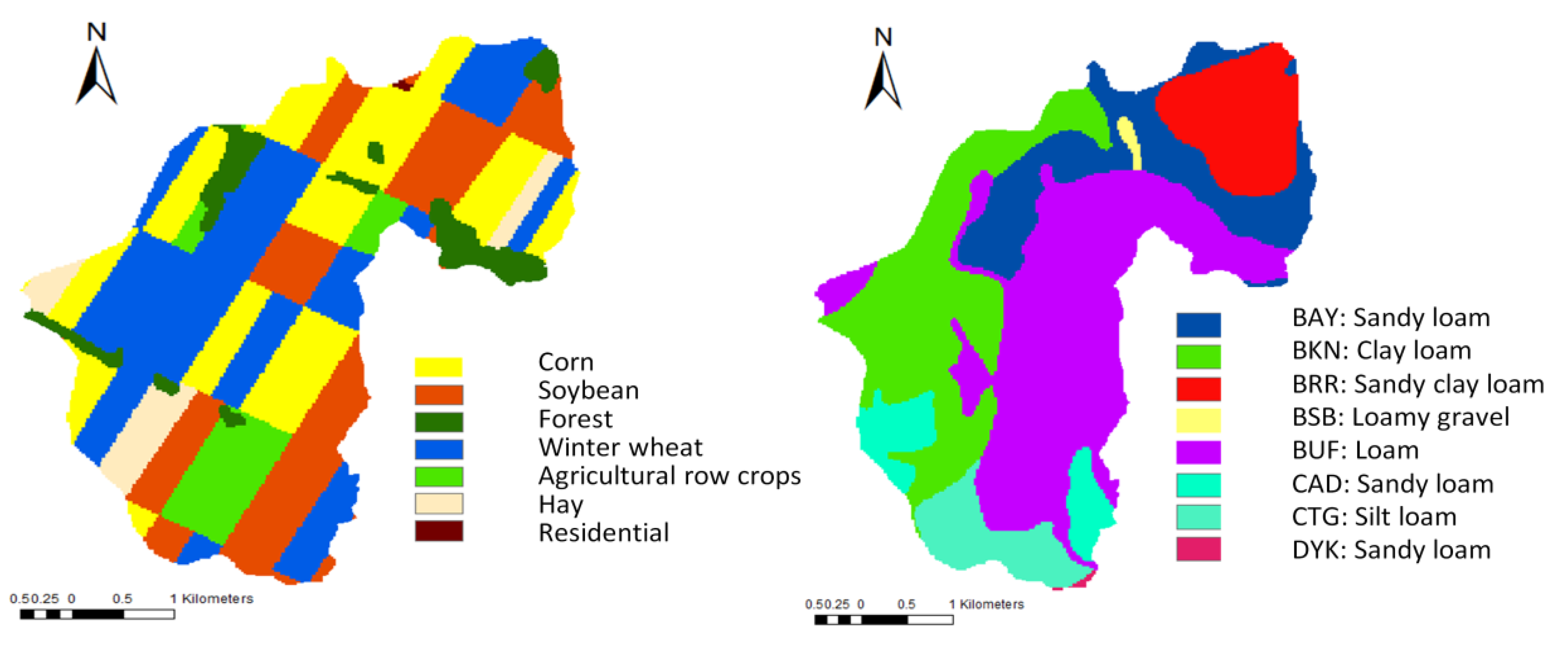
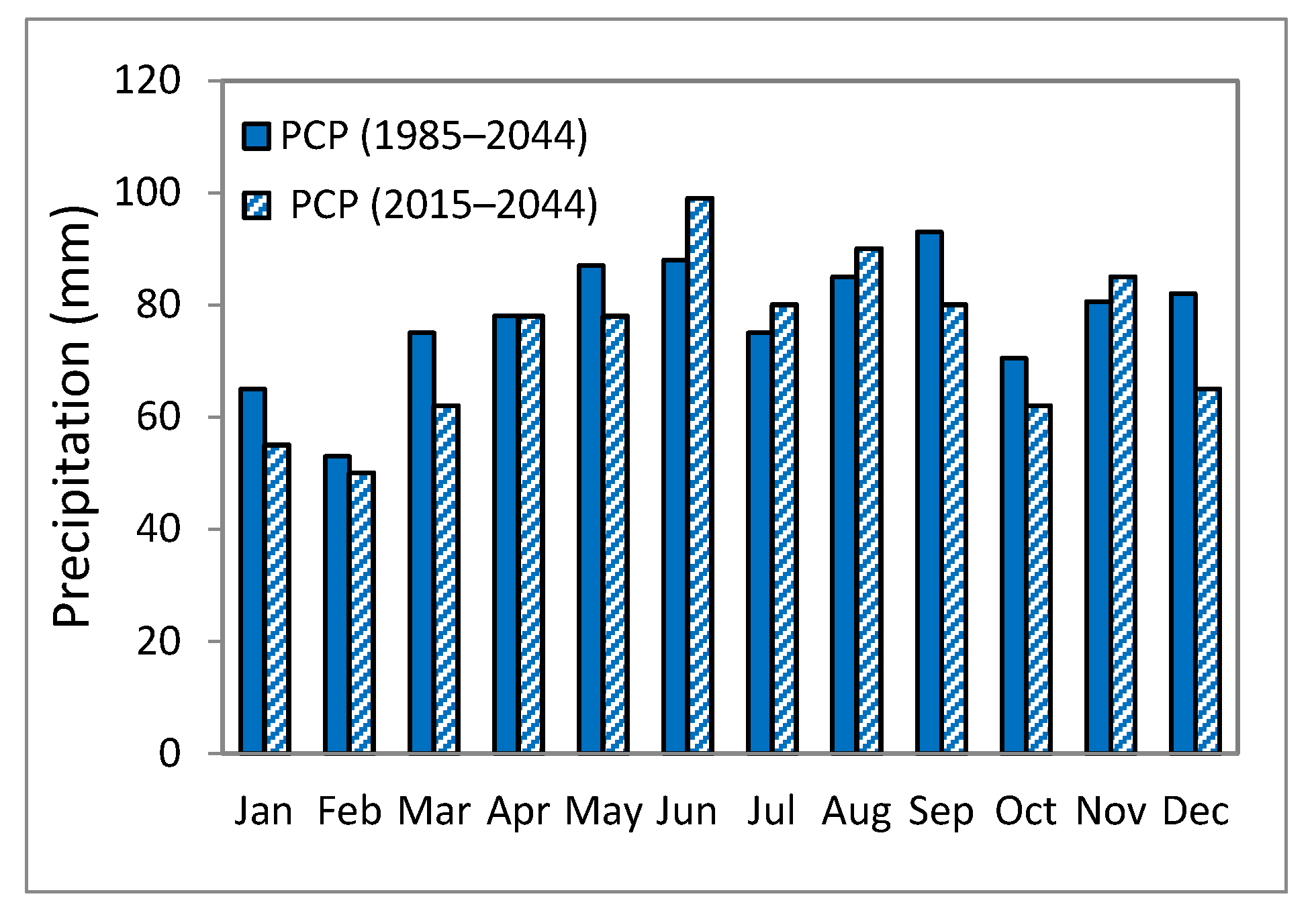

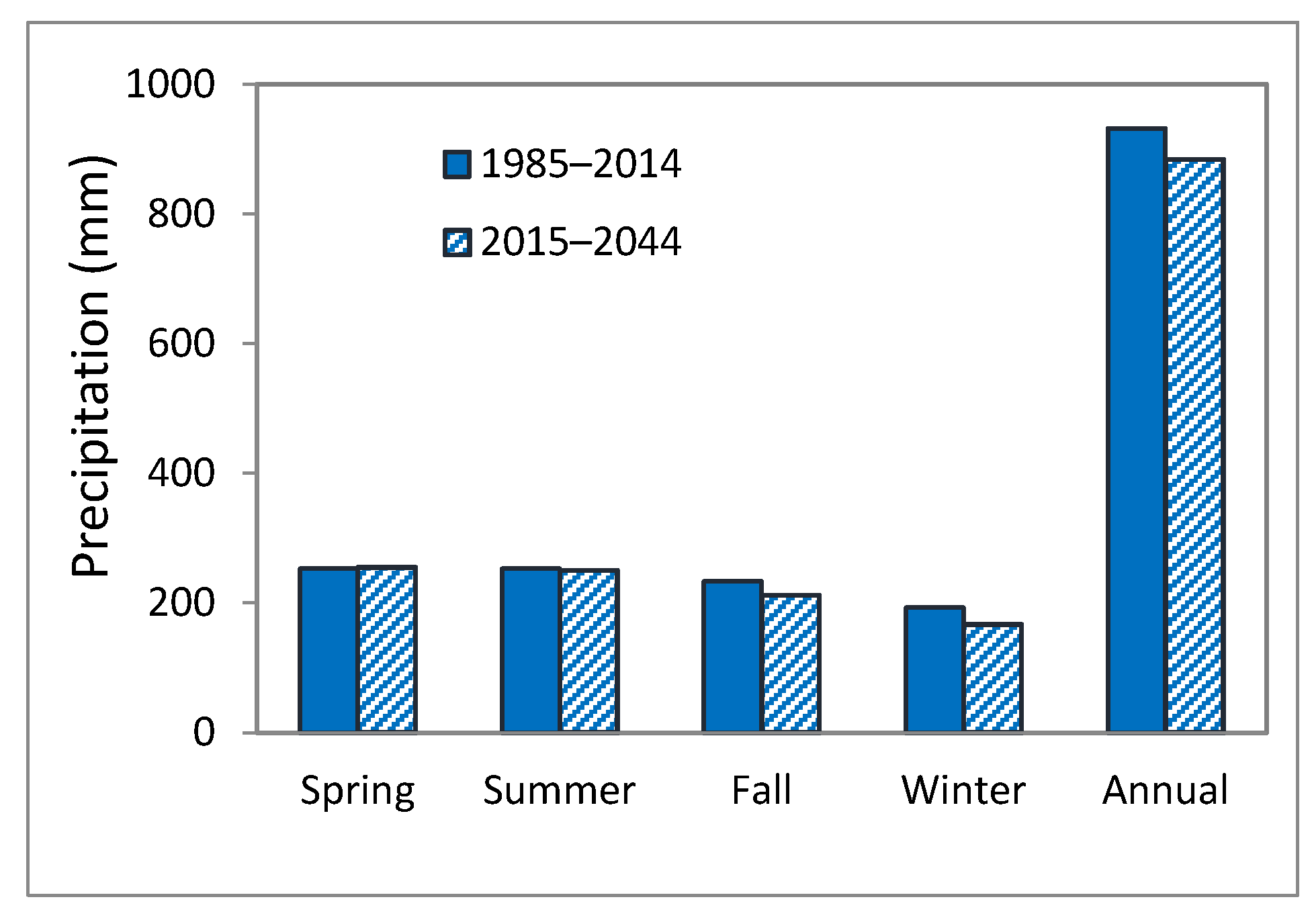
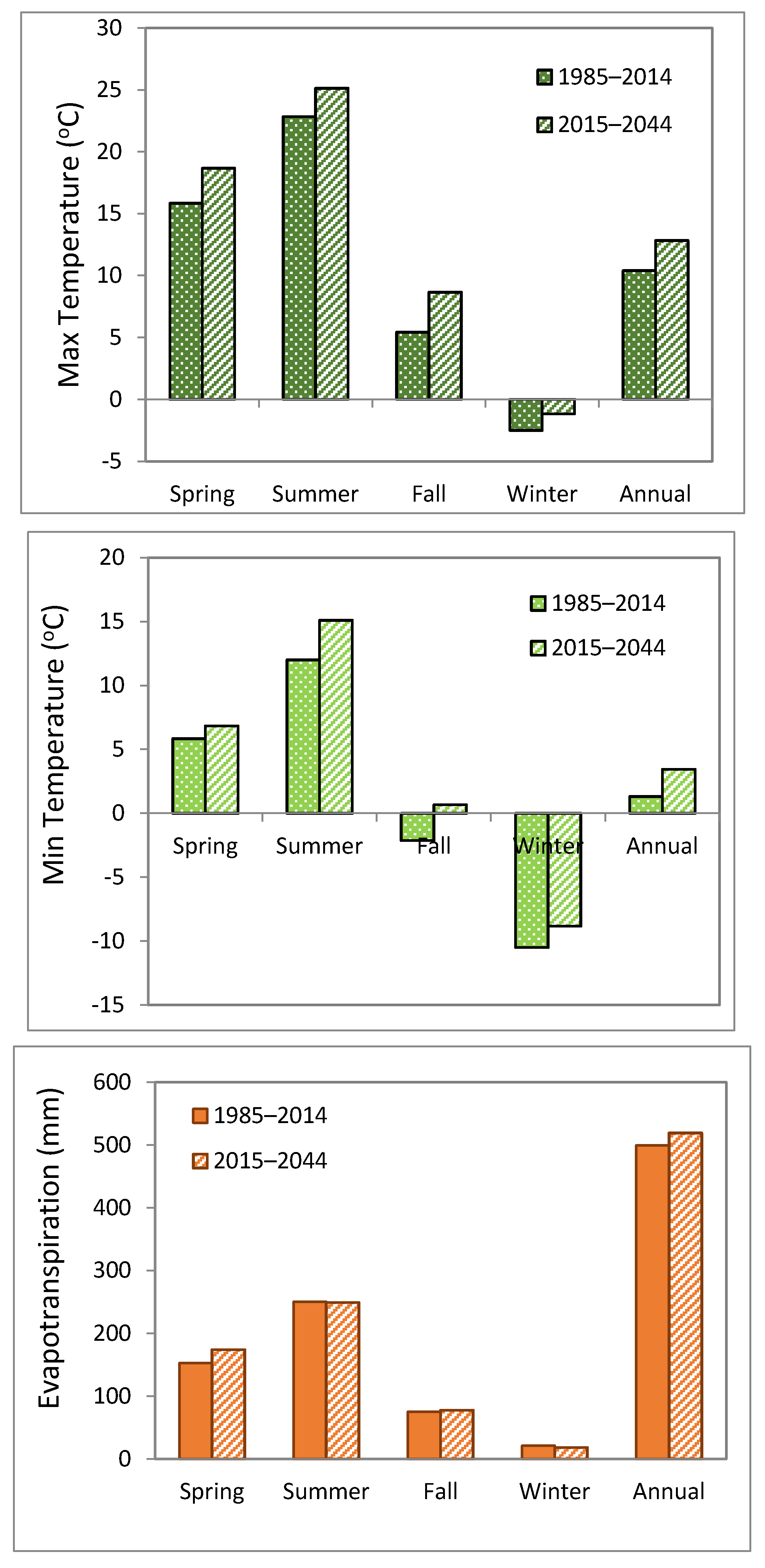
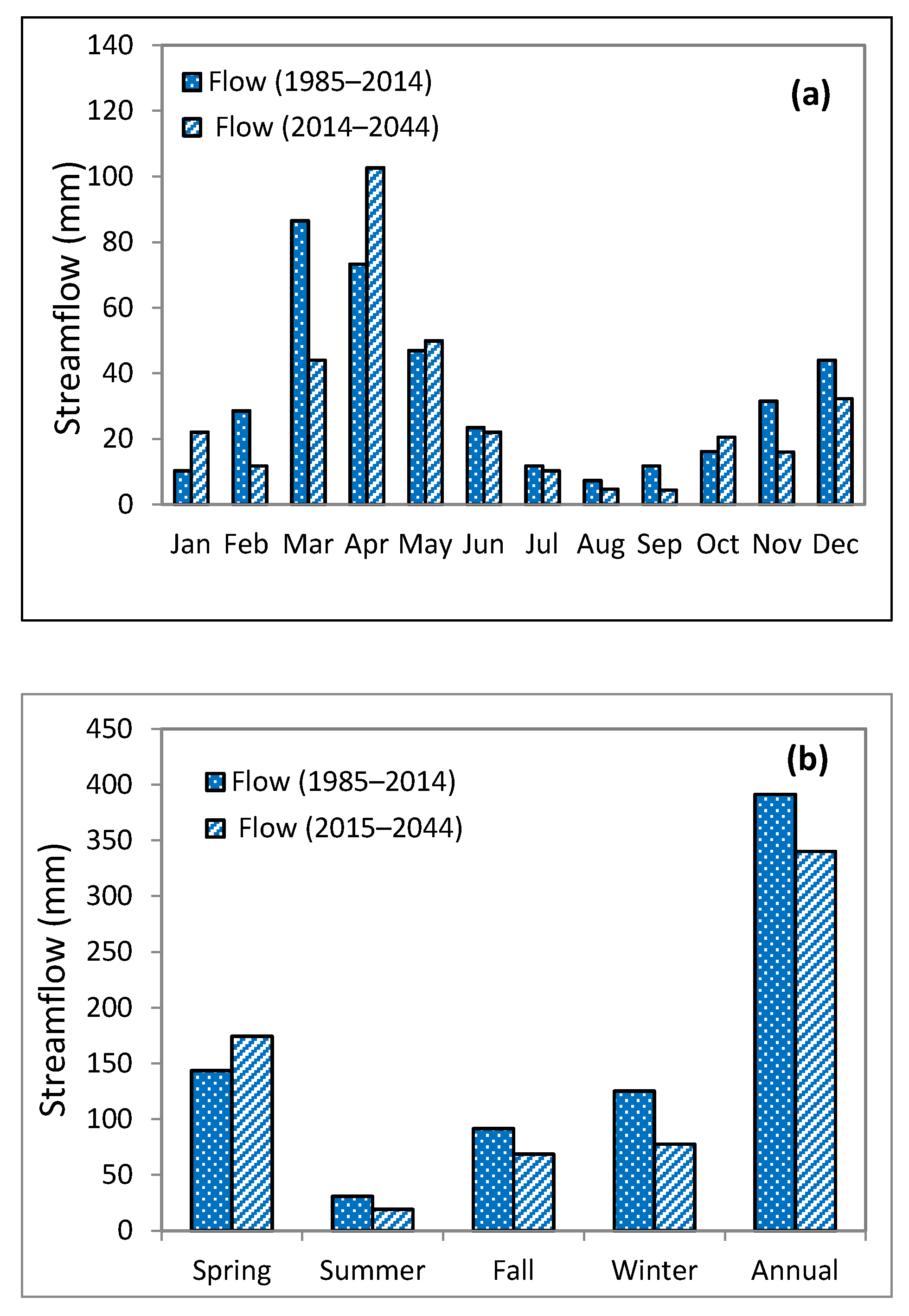
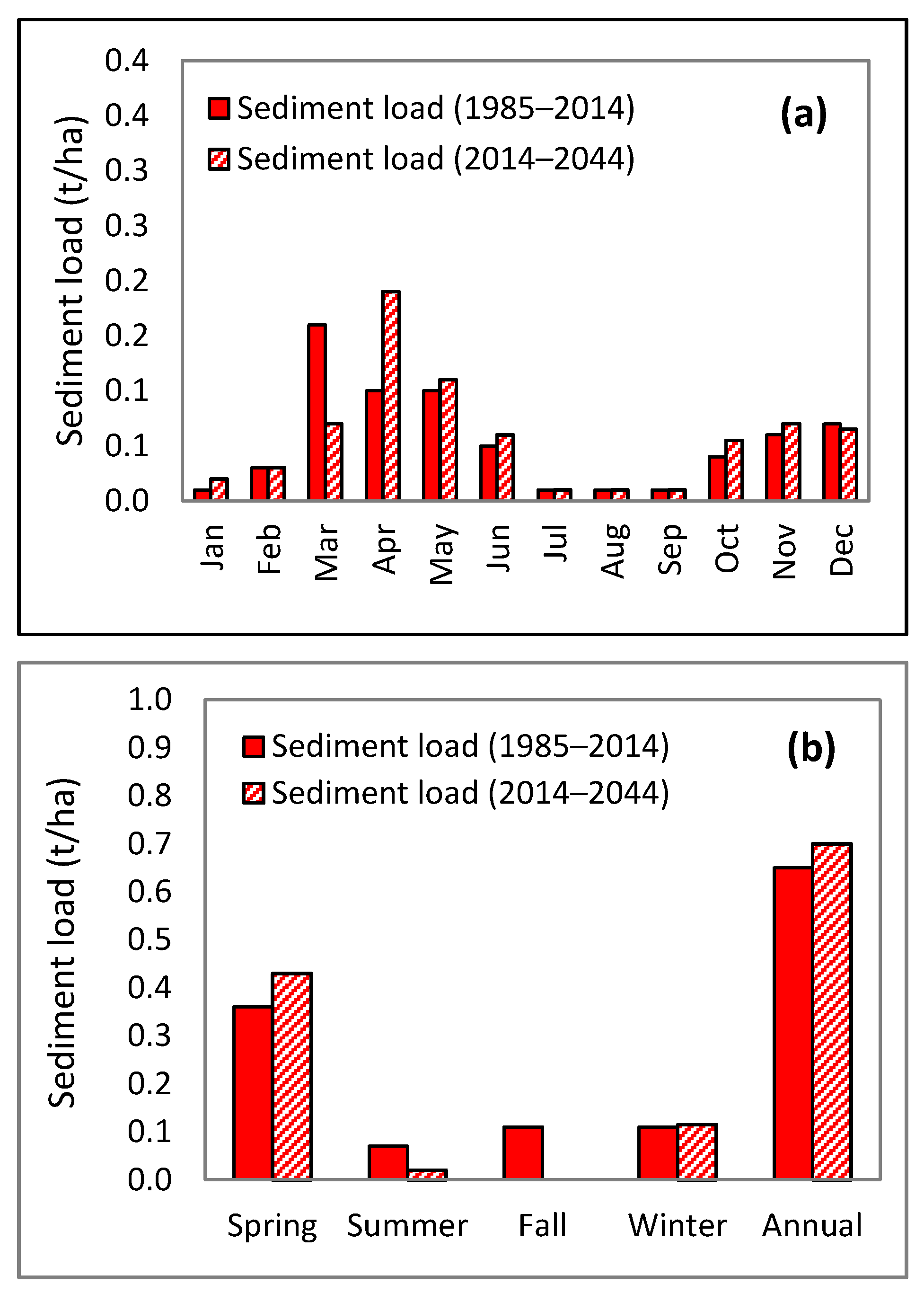
| Index | Monthly | Daily | Monthly | Daily | ||||
|---|---|---|---|---|---|---|---|---|
| Calibration | Validation | Calibration | Validation | Calibration | Validation | Calibration | Validation | |
| R2 | 0.92 | 0.82 | 0.85 | 0.75 | 0.88 | 0.89 | 0.82 | 0.73 |
| RSR | 0.27 | 0.37 | 0.36 | 0.47 | 0.41 | 0.44 | 0.48 | 0.49 |
| PBIAS | −6.07 | 3.67 | −6.07 | 3.67 | −1.71 | 25.88 | −1.71 | 25.88 |
| NSE | 0.88 | 0.74 | 0.78 | 0.60 | 0.83 | 0.80 | 0.74 | 0.71 |
| Predictands | Jan. | Feb. | Mar. | Apr. | May | Jun. | Jul. | Aug. | Sep. | Oct. | Nov. | Dec. |
|---|---|---|---|---|---|---|---|---|---|---|---|---|
| Tmax | 0.546 | 0.546 | 0.546 | 0.172 | 0.797 | 0.546 | 0.797 | 0.323 | 0.172 | 0.969 | 0.969 | 0.546 |
| Tmin | 0.546 | 0.172 | 0.172 | 0.323 | 0.172 | 0.130 | 0.546 | 0.323 | 0.35 | 0.082 | 0.797 | 0.172 |
| Pmean | 0.082 | 0.035 | 0.172 | 0.130 | 0.172 | 0.035 | 0.035 | 0.088 | 0.172 | 0.797 | 0.323 | 0.082 |
| Predictands | Items | Jan. | Feb. | Mar. | Apr. | May | Jun. | Jul. | Aug. | Sep. | Oct. | Nov. | Dec. |
|---|---|---|---|---|---|---|---|---|---|---|---|---|---|
| Tmax | Slope | 0.070 | 0.089 | 0.046 | 0.109 | 0.042 | 0.006 | 0.019 | −0.008 | 0.030 | 0.023 | 0.028 | 0.036 |
| p-value | 0.055 | 0.089 | 0.259 | 0.142 | 0.349 | 0.816 | 0.374 | 0.730 | 0.141 | 0.388 | 0.332 | 0.087 | |
| Tmin | Slope | 0.135 | 0.128 | 0.051 | 0.063 | 0.026 | 0.005 | 0.026 | 0.005 | 0.026 | 0.009 | 0.015 | 0.041 |
| p-value | 0.022 | 0.062 | 0.372 | 0.213 | 0.352 | 0.839 | 0.237 | 0.783 | 0.192 | 0.714 | 0.500 | 0.013 | |
| Pmean | Slope | 0.000 | −0.002 | −0.005 | 0.001 | 0.001 | 0.012 | 0.007 | 0.016 | 0.002 | 0.004 | 0.000 | 0.004 |
| p-value | 0.960 | 0.624 | 0.535 | 0.938 | 0.256 | 0.524 | 0.515 | 0.259 | 0.835 | 0.788 | 0.981 | 0.491 |
| Component | Historical | Future | ||
|---|---|---|---|---|
| Value (mm) | % | Value (mm) | (%) | |
| Precipitation | 975.8 | 100 | 937.0 | 100 |
| ET | 475.3 | 48.70 | 525.5 | 56.08 |
| Stream Flow | 392.4 | 40.21 | 339.5 | 36.23 |
| Base Flow | 143.4 | 14.69 | 152.8 | 16.30 |
| Snowmelt | 108.1 | 11.08 | 72 | 7.68 |
© 2017 by the authors. Licensee MDPI, Basel, Switzerland. This article is an open access article distributed under the terms and conditions of the Creative Commons Attribution (CC BY) license (http://creativecommons.org/licenses/by/4.0/).
Share and Cite
Golmohammadi, G.; Rudra, R.; Prasher, S.; Madani, A.; Mohammadi, K.; Goel, P.; Daggupatti, P. Water Budget in a Tile Drained Watershed under Future Climate Change Using SWATDRAIN Model. Climate 2017, 5, 39. https://doi.org/10.3390/cli5020039
Golmohammadi G, Rudra R, Prasher S, Madani A, Mohammadi K, Goel P, Daggupatti P. Water Budget in a Tile Drained Watershed under Future Climate Change Using SWATDRAIN Model. Climate. 2017; 5(2):39. https://doi.org/10.3390/cli5020039
Chicago/Turabian StyleGolmohammadi, Golmar, Ramesh Rudra, Shiv Prasher, Ali Madani, Kourosh Mohammadi, Pradeep Goel, and Prasad Daggupatti. 2017. "Water Budget in a Tile Drained Watershed under Future Climate Change Using SWATDRAIN Model" Climate 5, no. 2: 39. https://doi.org/10.3390/cli5020039





